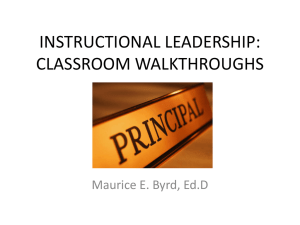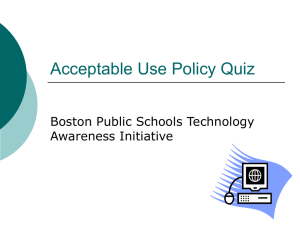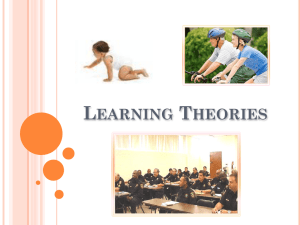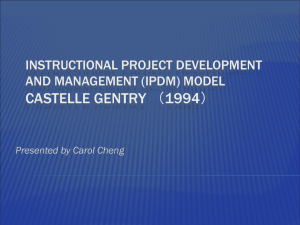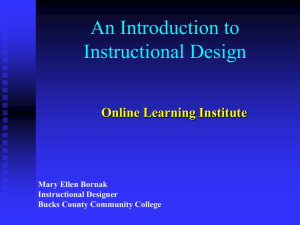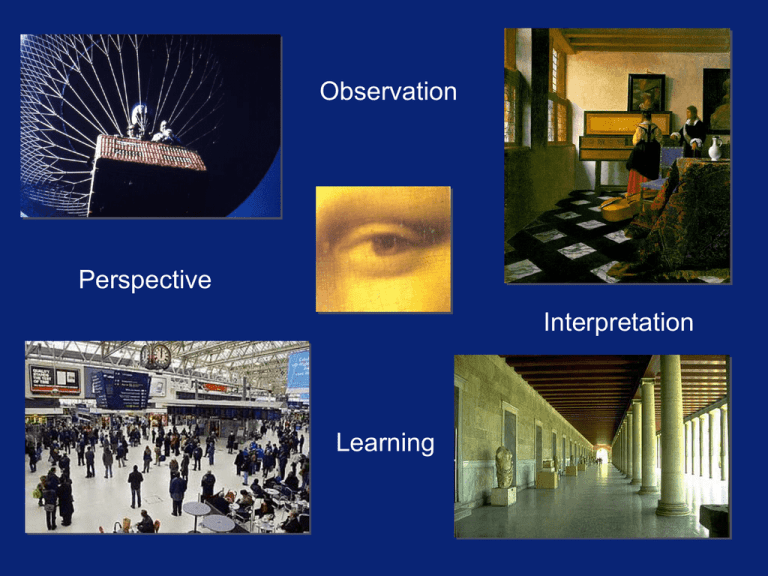
Observation
Perspective
Interpretation
Learning
Walking the talk:
Providing powerful instructional leadership through
effective school and classroom walk-through visits
(or)
The five-minute principal meets the one-minute manager:
Making a difference, one contact at a time
A component of the
Principals Module, Volume 2
National Center for Reading First Technical Assistance
Overview
School purpose & instructional leadership
Classroom visits: What gets in the way?
Breaking through the barriers
Setting up for success
The difference is in the details
observation
feedback
follow-up
Walking the talk
3
Purpose
What is your school’s mission?
(purpose, reason for being)
What is “Job #1” in your school?
What return do taxpayers expect on their
investment?
What do employers want from schools?
4
Beliefs
Given this mission (purpose) what do you think is your
role with respect to classroom instruction?
As a principal, the three most important roles I have to
assure effective teaching and student learning are .....
1.
2.
3.
5
Why do walk-throughs?
“The walk-through’s connected to the.....”
walk-through
instructional leadership
teacher effectiveness
student achievement
6
Purposes of walk-throughs
to improve instructional outcomes
to strengthen instructional leadership
be visible
be supportive
be engaged
be knowledgeable
to reinforce recent training teachers have had
to support the coaching process
to assure that time planned is actually delivered
to assure that RF elements are being implemented
7
Best practice
Instructional leadership is, perhaps, the single
most important role for principals to play when
increased achievement is the goal.
from
NAESP’s Leading Learning Communities:
Standards for What Principals Should Know and be able to do.
Why Walk-Throughs?
We focus our time on what we think is most
important
“If student learning is the most important function
of schools, then instruction is where we focus our
time and attention.”
Fielding, Kerr & Rosier, 2007
9
Instructional Leadership
“Very effective schools and districts consistently
have high degrees of:
purpose and focus
engagement
collaboration…
“…particularly around
learning
teaching
instructional leadership”
Wagner, et al, 2006
10
Why Walk-throughs?
“Performing a learning walk (instructional
walk-through) is a step that should be
informed by an understanding of what
constitutes quality instruction.”
“This clarity is key to actually making that
instruction happen.”
Wagner, et al, 2006
11
Why walk-throughs?
“Leaders can vastly increase their leverage
by becoming coaches.
“Each of the other roles the leader plays is
enhanced by the abilities s/he develops
when learning to coach, because ...
“coaching is a communication process
that connects people to performance.”
(Crane, 2002). The Heart of Coaching
12
Why walk-throughs?
“The data were clear: ...
“... the higher the level of response and
follow-up (by the supervisor), the higher the
staff rated their supervisor’s effectiveness.”
(Crane, 2002). The Heart of Coaching
13
Empowerment
“Empowerment is the natural complement
to accountability.”
(Sergiovanni, 2002)
Empower your teachers
through strong instructional leadership.
14
Choose your own role model
Think of a strong instructional leader
you have known. What do they do
that makes them a strong
instructional leader in reading?
15
Vision . . .
If “getting into
classrooms” was one of
your greatest strengths
as an educational leader,
what would it look like?
sound like?
16
Getting there…
17
What gets in the way
of being in classrooms?
meetings
district tasks
student discipline
staff needs
parent requests for time
phone/e-mail
organizational details
18
How can we improve our “in class”
presence and support?
schedule classroom walk-throughs into your
personal calendar on a daily/weekly basis
make an “appointment with yourself” to be in
classrooms
mostly during reading instruction
cover the range; differentiate your time
use self-monitoring (goal-setting & feedback) to lend
motivation & track your progress in meeting this goal
19
How can we improve our “in class”
presence and support?
Have your school secretary or another office person
“kick you out of the office” and “send you to the
classroom”
share your calendar of planned times with office staff
ask staff to remind you, if needed, that it’s time to go
to the classrooms
ask staff to protect this time from intrusions
ask staff to help you track & self-monitor visits
20
Sample Class Visit Log
gr./rm
week 1
week 2
week 3
week 4
total
K-1 (4)
x
x
x
2/4
K-2
x
x
x
2/4
1-4
x
x
x
3/4
1-5
x
x
x
3/4
totals
12/16
75 %
21
Self-monitoring of Walk-throughs
week
scheduled
completed
percentage
10/1-5
12
10
83
10/8-12
12
9
75
10/15-19
12
11
92
10/22-26
12
9
75
9.75
81.25
average
22
Make yourself accountable to
someone else for being in classrooms
make classroom visits part of the annual goals
you set with your supervisor
report to him/her monthly on your progress
use public posting of this goal and your
progress in meeting it
in the staff room, with feedback from staff
on a tally which students keep in the classroom
23
Self-Monitoring of Walk-Throughs
14
12
83%
75%
92%
75%
10
8
scheduled
completed
6
Average number
completed = 9.75
4
Average percentage
Completed = 81.25
2
weeks
0
1
2
3
4
24
Be collaborative
Set up an arrangement with another person
(administrator) to follow-through on being in
classrooms
Pair up with the coach periodically to walk through a
few classrooms and debrief together (a great
learning experience)
Invite a teacher to join you on a “learning walk”
set up a relationship with a mentor who will prompt
you and provide support, ideas and feedback
invite the superintendent, district administrators,
school board members or others to join you
25
Be competitive
Set up an arrangement with another person
(administrator) to follow-through on being in
classrooms
set up a friendly competition with a colleague (e.g. a
principal at another school) on # of classroom visits
in a week or month as a percentage of a goal
set a group goal where everyone (two or more
principals) contributes to the group goal (WY/ID examples)
26
Brief activity
Identify one or two of these strategies that
could work for you.
Tell a colleague about the strategy and ask
them to get involved in using it.
Write a note to yourself reminding yourself
to follow up on this idea.
27
Before you go in…
28
Before you go in:
Coordinate with the coach
schedule regular weekly meetings with the coach
have spontaneous check-ins as needed “on the fly”
Coordinate observation schedules
schedule some observations together (joint walk-thro)
arrange for complete classroom coverage
Coordinate observation focus & feedback
make the process consistent across principal and coach
coordinate differentiation of feedback
use data and previous walk-throughs to plan your visits
Who needs more support?
29
Before you go in:
Communicate with teachers
cultivate a team culture focused on student
improvement in reading
build a teaching-learning collaboration
communicate the norm of continuous
learning for students and adults
focus on the purpose of supporting strong
instruction for all students
state purpose and plans for classroom visits
share observation tool(s) you will use
30
Before you go in:
Communicate with teachers
talk about the process--what to expect
ask teachers what would be most helpful for
them as part of the classroom visit process
defuse anxiety
be positive, affirming, supportive & collaborative
state that you are learning, too
ask for their feedback on the process
clearly separate evaluation from instructional support
31
Observation/Evaluation
differentiate CLEARLY between these functions:
evaluation
formal
required
“summative” (like the state assessment)
observation
informal
collaborative
formative
not evaluative
32
Balancing principal roles
Evaluative (1%)
collaborative (99%)
formative
relationship-based
student-oriented
outcomes-focused
33
Before you go in:
Plan & coordinate your observation
Coordinate observations across staff:
Schedule and track your visits
Differentiated across staff, based on need for
instructional support
Include all who teach reading (e.g. assistants)
Include observations of all instructional groups
Guard against “convenient location” as a factor
Guard against tendency toward “comfort zones”
34
Helping adults change
35
Concerns-Based Adoption Model
Component: Stages of Concern
Unaware
Actively engaged
A model for understanding how
people (e.g., teachers) respond
to change initiatives
Component: Levels of Use
Resistant (OMDB)
Willing to try it
Expert
36
Levels of Use--Instructional improvement:
Changing adult behavior-One teacher and one skill at a time
The Concerns-Based Adoption Model
“Stages of concern”
“Levels of use”
37
Activity: Reflecting on “Levels of Use”
What are the key instructional strategies that determine
student learning?
Each strategy can be placed on a “levels of use” continuum
walk-throughs provide a valuable tool for doing this
Each teacher falls somewhere on each continuum
Our role as instructional leaders is to help teachers move
along each continuum
“Levels of use”
38
“Levels of Use” Activity (cont.)
Think about one skill continuum.....
Think of one of your teachers.....
Think about where this teacher is on this skill continuum
Think about how you can use the walk-through model to
move the teacher along the continuum with feedback, a
prompt, a question, or a suggestion and some follow-up
39
The places you’ll go,
The things you’ll see…
40
“The places you’ll go...”
classroom (for observation)
during reading instruction
all groups over time
strategic & intensive needs groups more often
hallway/classroom “rounds” (to confer with teachers)
common areas (for conversations with students, parents
and staff about reading)
cafeteria
before/after school
playground
hallways
41
The
things
you’ll
see
What does it mean?
Everything we hear is an opinion, not
a fact. Everything we see is a
perspective, not the truth.
Marcus Aurelius
A basic model for classroom visits
What do you see?
(the observed facts)
Why might that be?
(the present context)
What can you learn?
(the available lessons)
What might you say?
44
What to look for
What to look for?
What are the students doing?
correlates of learning & achievement
What is the teacher doing?
indicators of effective teaching
45
What to look for: Torgeson
“Are teachers providing explicit, well organized
and engaging whole-group instruction?”
“Is small-group instruction differentiated
appropriately by student need?”
“While the teacher is teaching a small group of
students, are the other students involved in
independent learning activities that are
appropriate and engaging?”
Torgeson, et al, 2007
46
What to look for:
Kennewick’s instructional framework
Purpose:
Teacher intentionally plans & instructs
for student achievement of essential learning
Rigor:
Each learner is appropriately challenged
as the teacher moves students to higher levels of
achievement
Engagement:
Tchr. & student actively participate
in the learning & are focused on the lesson
Results:
The intended learning is achieved
from Fielding, Kerr & Rosier, 2007
47
What to look for
transitions into and out of instructional time
readiness to teach (materials prepared/organized)
appropriate instructional pacing
management of student behavior
student opportunities to respond
teacher positive instructional interactions
appropriate student placement
instructional modeling/practice/feedback
effective use of correction procedures
positive feedback and other motivational procedures
48
“The things you’ll see...”
Teacher-led instruction
teacher with whole group
teacher with small group
teacher in tutorial (one-to-one with a student)
teacher in monitoring mode
other scenarios
students during instructional time
during whole group
during small group
during seatwork or center (independent) times
49
“The things you’ll see...”
teacher use of time & plans
Is the teacher “on plan”? (adherence to calendar)
lesson maps
where in program)
Is the instruction “on time”? (adherence to schedule)
allocated (planned) time
actual time
teacher management of transitions
students know transition routines
teacher actively monitors transitions
transitions are highly efficient to avoid loss of instructional time
50
“The things you’ll see...”
teacher knowledge of programs (context)
what training and support have they had?
does the instruction reflect the training and support?
are programs implemented with fidelity?
51
“The things you’ll see...”
student engagement
on-task, academic engaged time
opportunity-to-respond
“positive instructional interactions”
model-demonstrate-practice-feedback
correct as needed, then re-present task, praise improvement
100% participation
teacher pacing (# instructional responses/min.)
student skills are “firm”
52
“The things you’ll see...”
teacher is.....
on plan (following plans)
lesson plans (daily, weekly plans
curriculum maps (skills by time of year)
CSI maps (group instructional plans)
on program
evidence of training
fidelity to program
on time
allocated time (planned time--90+’)
actual time
53
“The things you’ll see...”
teacher feedback to student responses
APE--affirmation, praise, encouragement
specific
genuine
corrective feedback
tone
on point
check for understanding following correction
immediate test
delayed test
positive to corrective ratio
54
What if..... “The things you’ll do”
school hasn’t started
it’s a social setting
Ask teacher to highlight
progress with students
Ask kids.....
class hasn’t started
class is over
class is in transition
class isn’t doing what you
thought they would be doing
(cafe, playground,
before-after school)
What questions, probes to issue?
What can be learned?
55
What’s in your head?
Observational tools
56
Choose a tool
Choose an observational tool with which
you are familiar and which “does the job”
focuses on instruction and learning
makes data objective, not judgmental
or
The Five Minute Observation Form
(http//.oregonreadingfirst.uoregon.edu)
Florida grade-specific observation forms
(http//:fccr.org)
57
Cool Tools:
Technology-assisted walk-throughs
digital data collection devices
Google for “classroom observation software”
software can be used on a hand-held or laptop
some versions can generate instant feedback reports
58
Activity: Observation tools
Look at the observation tool(s) you use now
How do they fit with what we have
discussed about what to look for?
What are they missing?
How can you customize them?
59
What will you say?
60
One Minute Follow-up
The One Minute Manager:
one minute positive feedback statements
one minute corrections or teaching interactions
one minute goals
(from Blanchard & Johnson, 1982)
61
Follow-up: Not a monolog, but a dialog
dispel the myth of “one-way” observation
it’s a two-way street
principal can learn from teacher
teacher can learn from dialog
goal is a collaborative exchange about the
teaching & learning process
62
Follow-up Format
one positive comment
one prompt, question or suggestion
one follow-up component
“Where do we go from here?”
“Let’s touch base in a day or two.”
63
Follow-up Formats
ask questions/reflective probes
positive (for encouragement)
developmental (reflection for growth)
make suggestions
to get them thinking about teaching & learning
give feedback (“1’ manager”)
regarding program guidelines
set it up (training, demonstrations, etc.) peer observation
follow-up (to provide support & ensure it happens)
share an idea/insight
the 1’ workshop
idea (what), rationale (why), conditions (where/when), steps (how)
instruction, demonstration, practice, feedback, follow-up
64
Follow-up/Feedback
differentiating
by teacher
by situation or context
by training and experience
by skill and confidence (developmental)
65
Reflective prompts
delivered orally
done within 24 hours
non-threatening,
non-judgmental
stimulate thinking
specific focus
present or future tense
(not past)
reflective, not directive no answer expected
student-oriented
support offered
open-ended
from Classroom Walk-throughs, an on-line
training module. TeachScape, Inc., 2005.
(all rights reserved, used with permission)
66
Reflective questions
What strategies do your students use to
help them comprehend?
How can students make the leap from
decoding nonsense words to decoding real
words?
What do you think is most helpful to
students in increasing their fluency toward
benchmark levels?
67
When suggestions are needed...
2-3 positives for each suggestion
tie feedback to elements of your reading model
offer rationale for suggestions
offer context and situation for suggestions
teach the concept or skill
reduce to the “big idea”
instruction, demonstration, practice, feedback
What are your ideas? What is your style?
68
When you need more structured feedback...
not reflective, but directive
disruptive behavior
chronic loss of instructional time
your level of concern determines type of feedback
consider context and urgency
pattern of behavior vs. uncommon occurrence
(e.g. infrequent late start vs. consistently or excessively late start)
timing of addressing an issue (priority issues)
69
For starting discussions & supporting teachers
“And how are the children?”…(doing in reading)
Are the changes made at the last grade level
meeting working?
What’s going well in reading?
Would you be willing to share _ with others?
When are you doing _, would you let me know? I
want to learn more about it.
What is still a struggle in teaching reading?
How can I support your work in reading?
What are your expectations for your students in
reading? What is your vision for them?
70
How will you provide feedback?
face-to-face conversation
leave a note on their desk (handwritten)
leave a note in their mailbox (typed)
send them an e-mail
leave them a voice-mail
if in writing, follow-up face-to-face
What are your ideas?
71
When a teacher resists feedback...
check your style
supportive or evaluative?
depersonalize the feedback
let the data convey the message, then follow-up
appeal to core values
mission/vision
72
Where to from feedback?
connect to coach
connect them to others
facilitate networking among teachers
broker a mentoring model from one teacher to another
connect to discussion or training (past, future)
connect them to “why they became a teacher”
connect to a concept, “big idea”, principle,
connect to the culture (common purpose, vision,
belief, agreement, etc.)
inspire (help them envision student success)
reconnect with the passion of teaching
73
Follow-up
follow-up as indicated:
ask how it’s going
stop by to see for yourself
ask how you can support
affirm teacher effort to implement suggestions
ask them to think about connections
74
Practice from video
75
Video-dialog activity
Watch a video segment of instruction
With a partner:
provide a positive comment
pose a prompt, question or suggestion to
engage the teacher in reflecting on instruction
suggest a follow-up activity
Reverse roles and repeat the process
76
The Kennewick example
77
Kennewick’s lesson study process
Instructional study for administrators
Videotape and view high quality instruction
Five times/year--administrators expected to
participate
Administrators collaboratively view and discuss
instructional segments
Develops common understanding of high
quality instruction
78
Kennewick’s “Learning Walks”
3-4 principals & one or more district administrators
Purpose is to
Convene at least 1 x/year at each school
Visit several classrooms, looking for indicators of good
teaching & learning, then debrief
learn from each other
to develop the competency of the observers
to calibrate what is understood to be good teaching
from Fielding, Kerr & Rosier, 2007
79
Kennewick’s Two-Ten Goal
“Each administrator is expected to spend
Two hours per day or
Ten hours per week
on instructionally focused activities”
“60% of these are to be direct classroom
observations”
Fielding, Kerr & Rosier, 2007
80
Kennewick’s culture shift
Administrative “talk”
Less focus on athletics & “administrivia”
More focus on instruction
General agreement on what constitutes “quality
instruction” & what evidence supports it
Culture of excellence has emerged
Common vocabulary around effective instruction
More highly uniform level of quality instruction
from Fielding, Kerr & Rosier, 2007
81
Communities of Practice
& our response
82
Communities of Practice
“Networks of principals that exist to:
Develop members’ skills
Build and share knowledge
Transfer best practices
Solve real problems of teaching & learning
Wagner, et al, 2006
83
Communities of Practice
“Characterized by:
Commitment
Focus, passion & identification w/common purpose
Standards of practice:
Common definitions, expectations & practices
Job-embedded collaboration
Greater sense of efficacy among members”
Wagner, et al, 2006
84
Questions for reflection & discussion
What are the expectations for quality
instruction in our school or district?
How consistently do teachers and principals
in our district agree with what constitutes
quality instruction?
How can we more firmly establish these
expectations, definitions and commitments
in our school or district?
from Fielding, Kerr & Rosier, 2007
85
Questions for reflection & discussion
What would a principals’ community of
practice look like in our district?
What would we need to do to get this started
in our district?
What kind of collaboration could take place
across district lines to learn from each other?
How could these activities be part of the
leadership sessions within Reading First?
86
Walking the talk
87
Planning activity
Set a goal for increasing classroom walkthroughs--communicate it to a colleague
Choose a strategy for helping you get into the
classrooms more often (see what you marked in
the earlier brief activity
Identify and contact a support person to help
keep you motivated and moving toward your goal
Keep track of your classroom visits and note your
success!
88
A Challenge
Make a commitment to increase your visibility as
an instructional leader.
One effective way to do this is by increasing your
classroom walk-through visits.
Collaborate with one or more colleagues to learn
from each other & add motivation.
Set a goal & track your progress.
(Wyoming ex.)
(e.g. visit each classroom 1 x/week = 50+/month)
this = a lot of visibility, a lot of involvement, a lot of
instructional leadership & more teaching/learning
89
Planning for practice...
groups of 3-4
visit designated classrooms
5 minutes in the classroom
convene in hallway for 5 minutes
what did you see?
what questions or probes would pose?
what can be learned from the scenario?
90
Summary & closing
91
Summary: 7 disciplines
for strengthening instruction
Urgency for instructional improvement--from data
Shared vision of good teaching
Shared vision of student results
Collaborative discussion about teaching/learning
Active/effective supervision
Professional development connected to classroom
Formative data w/collaboration & accountability
Wagner, Keegan, et al, 2006
92
Summary
We can find ways to get into classrooms more often,
thereby enhancing our role as instructional leaders.
We can positively impact teaching & learning by doing so.
How we...
spend our time
focus our attention
spark teacher reflection & change...
all speak volumes about what we stand for.....
As we build a culture of collaboration around student
achievement, we empower each other to do our very best
work and thereby give students their very best chance for
success--in school and in life.
93
Let us fly high as instructional
leaders, and let our motto be:
“Veni, vini, confero”
I came, I saw, I conferred
…”Expertise in … instructional leadership,
which is foundational for (our mission), is
the craft at which our principals (must)
excel.”
from Fielding, Kerr & Rosier, 2007
95
Thanks to...
Katie Tate, for artistic & technical support
Marianne Oakes, for content support
Oregon Reading First
Ohio Reading First
Teachscape, Inc.
96
Resources
National Association of Elementary School Principals (2001). Leading
Learning Communities: Standards for what principals should know and be
able to do. Alexandria, VA: Author. Retrieved October, 2006 from
http://www.naesp.org/client_files/LLC-Exec-Sum.pdf.
Association for Supervision & Curriculum Development
http://www.ascd.org/portal/site/ascd
Phi Delta Kappa (Professional Association in Education)
http://www.pdkintl.org/
Oregon Reading First web site:
http://oregonreadingfirst.uoregon.edu
Florida Center for Reading Research:
http://www.fcrr.org
97
References
Fielding, L., Kerr, N. & Rosier, P. (2007). Annual Growth
for All Students, Catch-up Growth for Those Who Are
Behind. Kennewick, WA: New Foundation Press.
Torgeson, J., Houston, D., Rissman, L & Kosanovich, M.
(2007). Teaching All Students to Read in Elementary
School: A Guide for Principals. Portsmouth, NH: Center
on Instruction.
Wagner, T., Keegan, R., Lahey, L., Lemons, R., Garnier,
J., Helsing, D., Howell, A. & Rasmussen, H. (2006).
Change Leadership. San Francisco: Jossey-Bass.
98



